

Palazzo Ranghiasci-Brancaleoni has its own page in this website.
Palazzo Accoromboni (16th century)
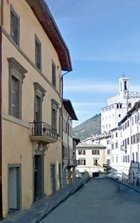
Palazzo Barbi (16th century)
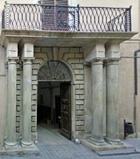
Marriage chests (16th century)
A pair of marriage chests in the Getty Museum, Los Angeles were documented here in 1643. They are carved in walnut and were originally partly gilded. A note inside says that they were gifts for the marriage of Cesare Bentivoglio and Pressilla de' Conti (which occurred in 1528). It adds that they were made by the “celebre scultore Maffei”, which was probably a reference to Antonio Maffei. However, the authenticity of this note has been questioned. The coat of arms that appears below the lock in the center of each of them belongs to the Conti family, and it is possible that the chests were made by a woodworker in their home city of Foligno.
Palazzo Beni (early 15th century)
The single facade of this palace unites a series of houses that belonged to the Beni family. It took on its present form in late 14th century, when the family returned from exile on account of its Ghibelline affiliations.
Two popes stayed here: Pope Martin V in 1420 and Pope Julius II in 1506.
The earlier buildings that form the palace are arranged around two courtyards, the larger of which is reached from the main entrance. The entrance dates to the 17th century.
A number of frescoed coats of arms in the smaller courtyard behind it are attributed to Ottaviano Nelli. Following their restoration, it became clear that:
-
✴the frescoes post-date the marriage of Duke Guidantonio da Montefeltro and Caterina Colonna in 1424; and
-
✴the arms of Pope Eugene IV were painted over an older fresco, presumably after his accession in 1431.
Other monochrome frescoes attributed to Ottaviano Nelli were detached from the main room on the piano nobile of the palace in 1898 and are now in the Raccolta Cagnola alla Gazzada, near Varese.
Palazzo Benveduti (18th century)
Text
Palazzo “Gabrielli” (late 13th century)

MCCCCLXXXX de mensa mai Betin Ponis f.f.
Bettino de Pone was documented as the Treasurer of the Commune in 1350.
Palazzo Marini (17th century)
History ?
[Two frescoes (ca. 1665) in the ceiling of one of the rooms of the piano nobile are attributed to Francesco Allegrini.]
Palazzo Pamphili (15th century)
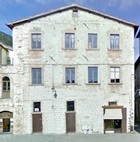
The nucleus of the palace was probably established in ca. 1342, the year in which Pietro and Putio Pamphili were appointed as heads of the “corpi di guardia” of the Quartiere di San Martino, charged with defending the city from Ghibelline aggression. It was later developed to form a palace with its facade in Via della Dogano (now Via Cavour). (This photograph shows its left side, in Piazza Bosone).
[Internal courtyard]
Annunciation (ca. 1450)
This fresco in an aedicule inside the palace, which was discovered quite recently, is attributed to Giacomo di Benedetto Bedi.
Palazzo della Porta (begun in 1495)
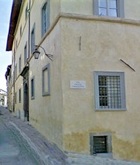
The palace has a fine Renaissance portal, with the arms of the Università dei Muratori e Scarpellini (guild of builders and stonemasons) above.
[The frescoes (ca. 1665) in three rooms of the piano nobile are attributed to Francesco Allegrini. Guazzugli ??]
Palazzo Toschi Mosca (17th century)
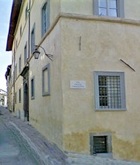
The relics of the obscure St Ticridina were translated from the chapel of the palace to San Filippo Neri in 1827. (Bishop Sebastiano Pompeo Bonaventura (1690-1706) had acquired them in Rome and brought them to Gubbio).
The family became extinct on the death of Vittoria Toschi Mosca, who endowed the palace for use as an old people’s home in 1877. It now houses the Casa di Riposo Mosca, a home for old people. [Private theatre on the piano nobile]

